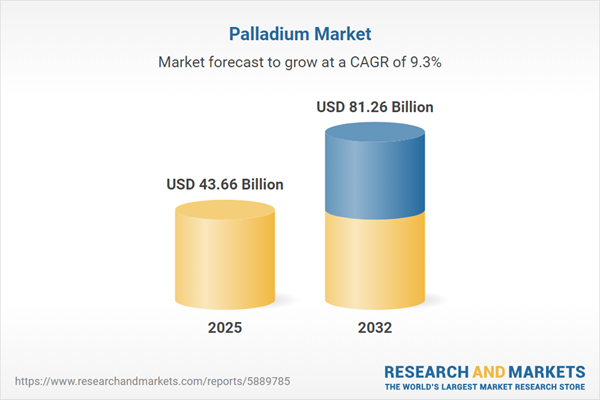Speak directly to the analyst to clarify any post sales queries you may have.
The palladium market is defined by rapid regulatory transformation and ongoing advances in material science. Senior decision-makers require the latest insights to steer procurement, sustain operational agility, and maintain a strong competitive position as the sector evolves.
Palladium Market Snapshot & Outlook
Current research values the global palladium market at USD 39.87 billion for 2024, with forecasts indicating further growth to USD 43.66 billion by 2025 and a significant rise to USD 81.26 billion by 2032. The sector maintains a robust 9.30% CAGR, signaling steady momentum and resilience. Driving factors include increasingly stringent regulatory requirements, innovations in material science, and expansion into core sectors such as automotive, electronics, and investment. Companies are re-examining their sourcing approaches and focusing on technology investments that support supply chain performance and organizational agility.
Palladium Market Scope & Segmentation
A thorough understanding of the palladium market allows senior leaders to align growth plans with compliance needs and adjust investments effectively. The following segmentation categories frame current industry priorities:
- Applications: Palladium is essential for automotive catalytic converters improving emissions control, industrial catalysts extending equipment life, high-performance dental alloys, electronics and telecom components supporting reliable conductivity, investment-grade opportunities, and durable jewelry manufacturing.
- Forms: The market offers palladium as bars, coins, granules, powders, and rods, accommodating a range of investor preferences, manufacturing requirements, and flexible sourcing strategies.
- Purity Grades: Key purity standards, including 99.9% and 99.95%, meet the strict quality needs of automotive and electronics sectors where performance and compliance are critical.
- End Users: Automotive manufacturers and chemical producers use palladium for regulatory compliance and technical innovation, while dental, electronics, and jewelry industries leverage its unique chemical properties for competitive differentiation.
- Distribution Channels: Distribution includes direct sales for large-scale agreements, global distributors for broad market reach, digital procurement platforms for efficiency, and retail options for added access and diversification.
- Regional Coverage: Regulatory environments, infrastructure, and supply chain dynamics differ across the Americas, Europe, Middle East, Africa, and Asia-Pacific. Recognizing these regional distinctions is key for effective go-to-market strategies and investment decisions.
- Companies Profiled: Lead players—MMC Norilsk Nickel PJSC, Sibanye Stillwater Limited, Impala Platinum Holdings Limited, Anglo American Platinum Limited, Jinchuan Group Co., Ltd., Vale S.A., Glencore plc, Johnson Matthey plc, Umicore SA, and Sumitomo Metal Mining Co., Ltd.—provide varied technological capabilities and demonstrate diverse compliance approaches across main markets.
Palladium Market: Key Takeaways for Senior Stakeholders
- Sustainable procurement strategies now guide corporate direction, helping organizations manage supply risks and demonstrate responsible sourcing to stakeholders.
- Product and catalyst technology advances reinforce palladium’s value in alternative energy and environmental applications, expanding its relevance across multiple industries.
- Palladium is increasingly integrated into institutional investment portfolios, offering a stabilizing influence and enhancing portfolio resilience against commodity market swings.
- Digital procurement systems drive operational agility, equipping companies to stay responsive as regulations and demand patterns shift.
- Enhanced focus on localized supply and regulatory adaptation allows businesses to navigate region-specific requirements, supporting operational continuity.
- The adoption of advanced recycling and extraction technologies within supply chains contributes to greater reliability, resource efficiency, and ongoing market competitiveness.
Tariff Impact on United States Palladium Supply Chain
Evolving tariff regulations in the United States have led manufacturers, particularly in automotive and electronics, to adapt sourcing models and stimulate new recycling initiatives. Closer partnerships with domestic refiners and targeted investments in materials management and compliance technology are helping organizations secure flexible, resilient palladium supply chains amid regulatory change.
Palladium Market Methodology & Data Sources
This analysis incorporates interviews with industry leaders, regulatory reviews, and independent expert validation. All data undergo multi-step verification to ensure executive-level reliability and tailored strategic relevance.
Why This Palladium Market Report Matters
- Enables decision-makers to anticipate risks and capitalize on opportunities as regulatory frameworks and technology continue to develop.
- Equips procurement and operational teams with compliance-driven regional strategies, reinforcing supply chain resilience and responsiveness.
- Delivers timely intelligence to optimize resource allocation, support decision-making, and sustain a strong market position.
Conclusion
Relevant palladium market intelligence empowers leaders to adapt procurement, compliance, and operational strategies as global sector demands and regulatory landscapes continue to evolve.
Additional Product Information:
- Purchase of this report includes 1 year online access with quarterly updates.
- This report can be updated on request. Please contact our Customer Experience team using the Ask a Question widget on our website.
Table of Contents
3. Executive Summary
4. Market Overview
7. Cumulative Impact of Artificial Intelligence 2025
Companies Mentioned
The companies profiled in this Palladium market report include:- MMC Norilsk Nickel PJSC
- Sibanye Stillwater Limited
- Impala Platinum Holdings Limited
- Anglo American Platinum Limited
- Jinchuan Group Co., Ltd.
- Vale S.A.
- Glencore plc
- Johnson Matthey plc
- Umicore SA
- Sumitomo Metal Mining Co., Ltd
Table Information
| Report Attribute | Details |
|---|---|
| No. of Pages | 183 |
| Published | October 2025 |
| Forecast Period | 2025 - 2032 |
| Estimated Market Value ( USD | $ 43.66 Billion |
| Forecasted Market Value ( USD | $ 81.26 Billion |
| Compound Annual Growth Rate | 9.3% |
| Regions Covered | Global |
| No. of Companies Mentioned | 11 |









